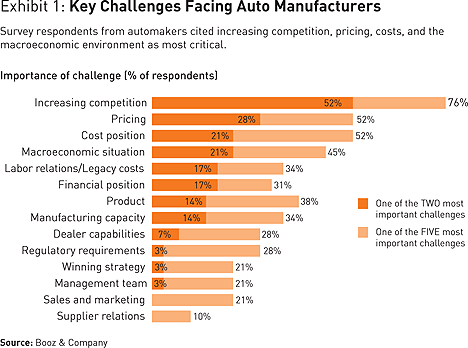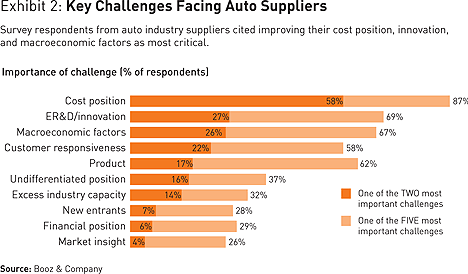Is the U.S. Auto Industry Ready for Growth?
The outlook for manufacturers and suppliers may be bullish, but a new survey shows that industry executives see big challenges ahead.
To many people, the U.S. auto industry appears to be on the mend. After an epic sales collapse in the wake of the 2008–09 recession, General Motors, Ford, and Chrysler were all profitable again in early 2011, and European and Korean manufacturers in the U.S. were also enjoying strong results. Only the Japanese transplants are facing earnings pressure, as they wrestle with massive disruptions to their global supply chains and production facilities, due to the earthquake and tsunami at home. Although the U.S. has slipped to number two behind China in auto sales, the U.S. market is still among the world’s most profitable, thanks to consumers’ enthusiasm for high-margin luxury cars, SUVs, and light trucks. Leading forecasters predict that light-vehicle sales in the U.S. will rise to more than 16 million in 2015, up from 11.6 million in 2010.
Yet auto industry insiders themselves are anything but sanguine. A Booz & Company survey of more than 200 executives from 40-plus automakers and suppliers revealed more modest expectations — only 13.5 million in vehicle sales in 2013 and 14.5 million in 2015. The reason: By the executives’ own reckoning, most automobile companies have not fully gotten their managerial houses in order. Almost half of the survey respondents said that the auto industry restructuring of 2009–10 did not go far enough. Two-thirds said that automakers and auto suppliers in general were not yet on a path to achieving sustained, full returns on invested capital. In fact, the auto executives viewed the overall tenuousness of their industry as so potentially serious that almost 30 percent said they expect a major automobile company to fail in the next two years.
For U.S. auto companies, the bankruptcies and restructurings — as well as the stronger focus on lean factories and new union agreements that grew out of the recession — have significantly reduced operational costs, sanitized balance sheets, and eliminated health and pension legacy expenses, or at least helped to make them more manageable. In many ways, however, those steps were the bare minimum necessary for the industry to survive the downturn. As Edward Tse, Bill Russo, and Ronald Haddock suggest in “Competing for the Global Middle Class” (s+b, Autumn 2011), car sales are increasing rapidly in the dynamic new global middle class of emerging markets — but new competitors are also proliferating to serve this market. Can today’s automakers continue to thrive in an industry that will be more in flux and more competitive than ever before? According to the survey, auto executives themselves are not sure.
“If you look at the industry before the sales downturn, it was hyperinflated,” says Ernest Bastien, vice president of retail market development at Toyota USA. “People were using their home equity and easy-to-get loans to take advantage of extraordinary incentives that were being offered. In fact, the industry was not as robust as it looked. Going forward, automakers are going to have to rely on a more fundamental but complex equation for growth: making the right amount of great, high-quality cars and proving to consumers that their brand is the best in terms of total cost of ownership, drivability, and reliability.”
When asked to rank their companies’ most critical challenges, more than 50 percent of the manufacturing executives surveyed chose increasing competitive pressure. (See Exhibit 1.) And although Japanese, Korean, and European rivals are certainly formidable competitors, the looming presence of Chinese companies casts the largest shadow. Fully 90 percent of these executives said that Chinese automakers would be making cars equal in quality to American-made vehicles by 2021. About half of all survey respondents, from manufacturers and suppliers, said this could occur by 2016. In other words, the executives said they believe that companies like Geely Automobile Holdings, which acquired the Volvo brand from Ford, and BYD Company, partially owned by Warren Buffett, will achieve in 10 years what Toyota and other Japanese companies took 30 years, and Korean automakers took 20 years, to do.

For auto suppliers, the future is uncertain as well — not because of potential changes in industry dynamics some years down the road, but rather because of a problem they have struggled with for at least a decade: Many find themselves unable to command full value for their products. Owing to an overabundance of competitors in most product categories, many suppliers lack the leverage to set terms with their automaker customers that would allow them to earn a positive return on their invested capital. They’ve become, in effect, low-cost order takers. As a result, many suppliers find themselves too short of cash to invest heavily in research and development. But that investment is imperative if they hope to distinguish their products from their competitors’ and go beyond merely selling commodities. Not surprisingly, given the dynamics of supplier relationships with the automakers, the two most widely chosen concerns expressed by suppliers in the survey involved cost position and engineering, research, and development (ER&D)/innovation. (See Exhibit 2.)

“A product’s price is directly proportional to the value it creates,” says David Johnson, chief executive officer of Achates Power Inc., which is developing an energy-efficient engine. “Any time that you aren’t delivering a unique technology or unique features that will create market demand or fill a real need in the market, your product becomes commoditized, and the next thing you are doing is price and quality competition. That is not a long-term winning formula.”
Clearly, suppliers have a long way to go to improve their relationships with automakers and to drive more value into their products. But according to the survey, auto suppliers do not see the path they need to take to get there. When asked to name the most important keys to winning, most suppliers did not cite two facets of a business’s operations that routinely count among the prerequisites for long-term viability: a well-defined strategy and deep market insight. Understandably, no business leader would argue against the importance of achieving the low cost position or providing superior customer service. But without a well-defined strategy rooted in deep market insight, it is nearly impossible to achieve a sustainable, differentiated position — which, in the end, is key to capturing the value created.
Given the responses to the survey, and taking a close look at current conditions in the U.S. auto industry, automakers and suppliers face different priorities in the United States (and elsewhere in the world).
The automakers must:
• Focus even more intensely on building attractive vehicles and rebuilding brands. Cars and trucks are still among the most visible, emotional purchases consumers make. In the current frugal and practical environment, U.S. car buyers need to be given reasons to “fall in love” again.
• Create vehicles with exciting design and styling; superior quality, reliability, and durability (QRD); and technological innovation. Although the QRD of vehicles sold in the U.S. is better than ever, meaningful gaps still exist between the highest-ranked companies and the rest of the pack, especially in longer-term reliability and durability. In addition, as breakthrough innovations in safety, “connected vehicle,” and power-train technologies emerge, new opportunities must be created to deliver differentiated value to consumers and drivers.
• Make sure that each vehicle produces a positive return on investment. Hoping that a few blockbusters will generate most of the portfolio’s returns — as many automakers have done in the past — is no longer sustainable in a more competitive and smaller U.S. market.
• Continue minimizing relative material and structural costs while bringing new technology to market cost-effectively, earning fair returns for product innovation.
• Prepare cost structures and innovation processes for a more globally competitive landscape.
Auto suppliers should:
• Accelerate efforts to find greater leverage with high-quality product lines. This means a supplier must innovate wisely, focusing on features that consumers are willing to pay for, creating end-user pull, and establishing itself as the company best positioned to help solve manufacturers’ problems.
• Better manage portfolios, focusing on the markets where the suppliers have the greatest capabilities and opportunities to create a sustained competitive advantage, and to meet changing market needs. Although some companies are able to prosper making disparate components, most do not have the resources and skills to do it well.
• Continue to aggressively manage costs. Suppliers reduced operational and structural costs during the downturn. Now, they need to make sure that these expenses don’t creep back in as volumes ramp up. They must also discipline themselves to stop chasing automaker contracts that cost more than they return in the long run. Where possible, suppliers and auto manufacturers should promote collaborative cost-based agreements that give manufacturers full transparency into relevant supplier operations and, in exchange, allow suppliers to earn a fair return on investment.
• Recognize that industry consolidation is likely to intensify. For each core business, suppliers should decide: Am I a buyer or a seller?
The U.S. auto industry is in a period of extraordinary transition. Whether one considers alternative drive trains, or ways to fine-tune designs and manufacturing processes, or a raft of new global competitors, it’s fair to say that only the most flexible, lean, and well-managed companies will survive. With that in mind, perhaps the survey’s greatest value is its central finding: Despite the general optimism in the auto industry today as well as the real improvements in efficiency, quality, and lean practices that have been made, many executives are still bracing for further change. They will need all the courage, and skill, they can muster. ![]()
Reprint No. 11301
Author profiles:
- Brian Collie is a principal with Booz & Company in Chicago. He specializes in working with automotive and industrial clients in the areas of business unit transformation, new market entry, and corporate strategy.
- Scott Corwin is a partner with Booz & Company based in New York. He has extensive experience in assisting clients in developing creative and pragmatic growth strategies for the automotive, media, and consumer industries.
- Patrick Mulcahy is a senior associate with Booz & Company based in Cleveland. He focuses on product strategy and M&A for automotive and industrial clients.
- For a detailed analysis of this survey, see “Facing New Realities: What Comes Next for the U.S. Auto Industry” (PDF).

